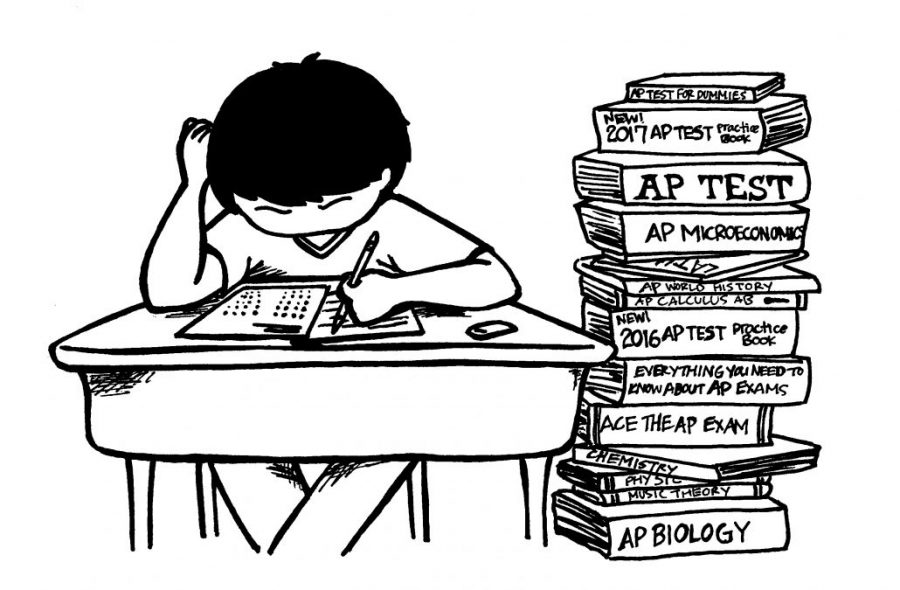College Board’s Muddled Marketing & How it Hurts Students
Why do AP classes feel like such a drag? And what do they actually do for students in the end?
 Have you ever been in an argument over something minor, then later found that this small incident is demonstrative of a much larger issue in that person’s life? They forget to buy you a birthday present, but then you find out they actually don’t buy anything and haven’t bought groceries in months. Replace that person with a billion-dollar public institution, and forgetfulness with disingenuousness, and you can begin to understand the sort of precarious situation that the non-profit College Board has found themselves in. Known for their administration of the SAT and AP programs, College Board is now trying to secure themselves a position as the premier provider of modern, rigorous quality education as well. But this path has not come without its pitfalls, and much more than a friend being left present-less, real students are limited by College Board’s failures.
Have you ever been in an argument over something minor, then later found that this small incident is demonstrative of a much larger issue in that person’s life? They forget to buy you a birthday present, but then you find out they actually don’t buy anything and haven’t bought groceries in months. Replace that person with a billion-dollar public institution, and forgetfulness with disingenuousness, and you can begin to understand the sort of precarious situation that the non-profit College Board has found themselves in. Known for their administration of the SAT and AP programs, College Board is now trying to secure themselves a position as the premier provider of modern, rigorous quality education as well. But this path has not come without its pitfalls, and much more than a friend being left present-less, real students are limited by College Board’s failures.
In recent years, College Board has fallen off the pedestal of the nation’s most prominent high school testing organization, with fewer and fewer colleges requiring students to take the costly and time consuming SAT. College Board has marked a nearly 700,000 person difference in test taking attendance from 2020 to 2021 [1],largely due to the pressures of COVID-19 making colleges temporarily suspend the requirement. But pressure against standardized testing, especially the expensive and mandatory kind that the SATs represent, has existed for many years, particularly on the basis that it is a discriminatory way to consider students’ performance [2].According to the Hechinger Report, an institute that studies education inequality,“Low-income students typically have lower scores than their more affluent peers…because families with more money usually live in wealthier school districts with more resources and can afford tutors to help with test preparation and other educational assistance.” Education Corner, a college prep service, elucidates that with low test scores, “perfectly capable students find themselves locked out of… college.” Even prominent test givers like College Board themselves recognize the ineffectuality and floundering orientation of standardized tests [4]. This year almost 1700 higher education institutions have waived the requirement for a standardized test [3]. Prominently, the University of California, which provides college education to nearly 300,000 students, has waived the requirement. (For more background on the issue of standardized tests, I would recommend the article Pencil’s Down, by Amber Dance for Knower magazine. It serves as a great background to this investigation.)
But College Board is a business. And while from 2012 to 2022 they lost their place as a standardized testing institution, profits have remained the same. Indeed, revenues have grown, along with the prominence their other educational arm: The Advanced Placement program. In 2021, College Board made a record $409 million from AP tests alone, at a cost which has risen from $83 per test in 2007 to $95 in 2021 and $96 this year [5]. College Board has made this shift nearly unnoticeable. Even on their own website, College Board still lists the SAT as their primary involvement, while overwhelmingly in recent years their command over AP curriculum, AP tests, and the inclusion of higher order content in high school education has been their preeminent authority.
It must be noted that there is a powerful resemblance between the orientation that College Board takes with both the SAT and AP program. In both cases, overwhelmingly, the end of the program as expressed to students and colleges is the test. You study and you practice, and that can inculcate good rigorous educational skills, and you might even build some connections from it; but at the end of the day the programs are lynch pins. The cutoff of the test, the score you get in May, is the holistic conclusion of your endeavor. This does two things: Firstly, it leads to an immense amount of trepidation in students, who demonstrably would otherwise be perfectly suited for the topic or the rigor, but who when confronted with the prospect of the test shy away from their own success. This leads to a survivorship bias of sorts. It is easy to say that the test, SAT or otherwise, is a good gauge of say, college success, when the test is necessary to get into college, and all the people who are too scared to take the test confidently therefor don’t get in, or get in to the same level college as those who are in all other metrics their peers. We have seen, once the requirement disappears, the “whole” student which that test metric purports to represent actually comes to the fore of the discussion, and can be treated truly holistically, rather than (and this puts it bluntly) as just a number. Secondly, the orientation solely towards the test restricts the program, and coerces all its applicants, teachers and students, to align themselves only to the test. Some teachers have even said, “You are in this AP class to take the AP test. I do not want you in this class if you do not have the intention to take the test.” This leads to a plethora of issues we will get into later.
The ineffectiveness of standardized testing is old news, and now College Board is about choice in education, equity, and rigor. Those three fundamental values, choice, equity, and rigor are the core of College Board’s design by their estimation: What must be considered though is if those values are integrated into the program, or if they are just a topical veneer, a doxastic design which structurally benefits College Board’s sales. Even more than that, it’s important to examine, much like the issue of standardized testing, if the values behind the program are useful to students in the way AP says they are. In much the same way your birthday-forgetting friend tries to weave around and hide their unreliability through muddling the conversation over the issue, College Board has been known to use the existence of a continued debate to cover up the unnecessary nature of the whole program.
When it comes to millions of dollars of student’s money every year, and the quality of their education on the line, we must hold College Board accountable for their muddled marketing.
Let’s first examine College Board’s claim of AP classes being used a tool of equity in schools. According to a 2017 New York Times article, at the height of the conflict over SAT equity, College Board was rolling out campaigns across the country that touted AP classes as necessary because they represented a normalized curriculum that all students can access evenly regardless of regional discrepancies, and because they bake in the corollary “soft skills” (time management, writing, analysis, application, etc.) to that curriculum. College Board’s “All In” program, as well as lobbying for expansion of AP class selections in all schools regardless of region or funding, have largely brought them in line with equitable education standards[6]. Notably, minority engagement in AP testing has increased a large amount in recent years, bringing it in line with wider population averages for schools. It must be considered, though, that test enrollment does not demonstrate holistic equity. Underserved schools underperform on AP tests, even while committing more students to them over time. That very same New York Times article related a school in DC where the average AP student, who is very receptive to the more “advanced” curriculum, will often get a score of a 1 or a 2 on their AP test in that class, which would not be accepted at any college.
Don’t these two facts seem contradictory? On the one hand, AP classes are clearly directed as a college preparation tool, focusing on educational soft skills. And in the case of the schools studied by the New York Times it seems like at the very most those skills are being engaged with only on a classroom to classroom basis. But on the other hand, AP classes are sold as an equitability tool, regularizing curriculum between different areas. If it must be engaged with on a classroom to classroom basis, and the material is homogenous between classrooms, and the test is still mandatory, it seems as though testing on that material is demonstrative of those very same extraneous factors of privilege which were demonstrated by the SAT.
Again, it feels as though these are incongruous goals. The New York Times explains that many students were enrolled in AP classes because of the belief in their expediency in equalizing their educational opportunities. Though, at the same time they were not able to demonstrate that equalization, in either wrote tests (which we have established to not be overly trustworthy) or in direct application (which may be the more crucial, post-secondary skill). AP did nothing to support these student’s growth through the AP program, it just placed expectations on them going in, and reflected those expectations on them coming out. For an advanced, college-adjacent program, that does not seem developmentally sound.
Following that, just as colleges are disregarding standardized tests due to inherent bias, it appears that they similarly disregard AP test scores, even perfect ones, because too-perfect scores from specific schools point to advantages coming from outside of the program, which covers up the qualitative considerations of a student’s work, and vice versa for too-poor scores. And again, we must remember each test costs $96. Theodore O’Neill, a former dean of admissions for University of Chicago, put it best: “There has been a tremendous push to market for good and bad reasons. I think the whole accumulation of power in the hands of the College Board to determine what a curriculum should be is suspect in itself.” Under this consideration, U-of-C does not accept credit from AP tests for most AP classes. Given this, for student equity it would be best if the AP test was free, proposes former Assistance Secretary of Education Diane Ravitch.
This idea, of the dissonance between the high cost of the test and the purported equity-focused design of the program, was the initial spark behind my interest in the real values that underly AP classes, and how those values may or may not line up with how they sell themselves. Why are AP classes presented in such incongruous ways, and what does it do for College Board for the narrative around these classes to be so muddled? Throughout this whole exploration, you should keep in the back of your mind that College Board makes, from voluntary student testing, over $400 million dollars per year, much of which was subsidized through mandatory testing programs in state and federal education policy.
Talking with a selection of AP teachers here at Carver Center, representing a wide range of subjects, a few key themes emerged. Firstly, every single teacher we spoke with expressed that the climate and expectations of the course were firmly theirs to dictate, and weren’t overwhelmingly affected by College Board’s program. Ms. Weisman, an AP Literature teacher, explained that College Board is “very helpful in developing individual curriculums for teachers, providing online curriculum materials, especially now with tools like AP Classroom and AP Central which have a lot more [on teacher’s ends that students don’t always see].” But, she relates, as with most of her peers, teachers set the main expectations that govern student engagement. This interestingly went against one of my personal thoughts on the value of AP, that the program itself selects for more engaged students. But contrary to my untrained opinion, the vast majority of evidence shows that classroom environment and the quality of student engagement is largely always dictated by the teacher. Carver Center is actually a perfect testing ground, because we draw from such a massive swath of schools and get all kinds of students coming in, and because issues of intrinsic motivation can be controlled for, due to the “you chose to be here” mentality of students (which will factor into the next article in this series about what the AP program has coincidentally done correctly when it comes to providing a modern, rigorous education).
In another Carver Center specific regard, it’s interesting to consider the intersection of career related rigor between standard and AP classes. Speaking with Mr. Pritchard, the AP Computer Science teacher, similar problems can arise regarding curricular rigor not aligning with student needs. Mr. Pritchard noted significant differences between requirements for learning which tie into the conceptual methods of AP Computer Science A, and the more project/portfolio based work done in the IT/IMP prime. The focus on the dynamics of the AP class, especially towards the test and the structure it forces on the year, limited the number of opportunities that students got to have a college relevant application of their knowledge, especially when it came to depth of language acquisition and case application. While CS is a pronounced example of this issue, from all interviews there was a clear trend in AP classes that the students had to find places for their own application of the material, whether due to the profusion of material, or the speed of instruction not providing for deeper dives. In non-AP classes, more opportunities were provided for those alternative engagements. More often than not, it was the burden of the teacher to impress the practical applications and of both teacher and student to create the rigorous connections that underly the rote rigor of a normal college course. This was noted as well in courses that students have expressed a moral value towards, or where the application is particularly centered in the manner of the material, like AP Environmental Science, or AP Government and Politics.
Ms. Weisman noted some short comings with the test based structure of the course, and the way that teachers are judged on their test performance. “Because of the way equity is treated by the program, teachers get judged on their test scores, and some teachers can cherry-pick who gets to take the AP test because of that. It’s nothing against those teachers, [it’s just what happens].” She stressed though that this doesn’t affect the quality of the teaching, but that often it is one of the few tools that teachers can use to protect good quality teaching from the burden of the test. As noted before, since teachers are often coerced into treating AP classes like AP test prep, its not much of a surprise that they have to even manage their classroom with the test in mind. The pervasive, coercive quality of the test should not be understated: It should be recognized as an issue, all the more because it is not often the predominant thought in AP classes minds. Again the refrain, College Board makes you pay $96 a test, and the less they get you to think about that test, the more likely you are to pay.
“My honest recommendation with APs is that, if you are taking the class for the credit in college, take the AP classes in the classes you like the least,” said Mr. David Cox, who teaches AP Physics at Carver Center. He boasts one of the smallest classes in the school, with a mere 7 students in one of his AP Phys 1 classes. Even still, he is not fully convinced of the class climate and curricular benefits of AP. “If you’re a science person, and you don’t like English, take English AP, test out of the Gen-Ed English you take in college and you don’t have to see it again. Take AP classes in the areas you’re interested in, to get more depth in those areas and explore, but I wouldn’t recommend you try and test out for college. At the very least, you get some background going into freshman year so you can stress a little less on the content, and take some time to actually learn how to be a college student, with the greater freedom and other [dynamics of the college environment]… You’re really just going to pay to take a test… to get out of taking a test? Which I don’t much get. I would love to see AP allow you to sign up much later, after you’ve seen the content, after you know how much you are really interested in it and how well you can do it. It feels like putting the cart before the horse.”
A slightly different sentiment was presented Ms. Litz, who teaches AP Government and Politics, which Carver Center uniquely offers to freshman, along with AP Environmental Science. “The assessment is a similar factor in both cases [of AP and non-AP classes]. They have their own deadlines and own standards to meet, [which the content orients towards]. There are moments where there is more leeway in the Baltimore County curriculum to dive in deep with a topic, but [again] they still have the same restraints… AP is definitely a higher standard of performance compared to Baltimore County curriculum. It’s sad to say that students can come into the course with different levels [of the corollary skills for my subject], based off of where students came from across the county. It’s kind of eye opening, because I am one of the first [AP teachers] they get, they come in with [different skill-sets class to class, and different] rigor that they are accustomed to. And AP doesn’t really look at this at all. AP Gov is an odd course because it’s technically an elective… with the [problematic] expectation you’ve already taken AP US History… We think you’re able to do it [as Freshmen, as an introduction to the AP method].” She noted at the end of the interview that “They grossly simplify the material. It’s a lot less intense than they say it is, [and] they put in a lot less material than there really should be, for how rigorous they say [the course is].”
Some students and teachers have said that the facts and practices in an AP class, the information you memorize, can give you a boost in college. Mr. Cox’s sentiment was reflected by college level students who say AP served as a good basis of skills to “review” in Freshman year, rather than learn anew. But, as often as this is lauded it is countered by the fact that much of the information garnered in an AP environment is also included in the standard curriculum. The outcome here might be skewed by the fact that AP develops a separation in schools between students who intrinsically care about the content and those who are more ambivalent. In other words, because AP students are conditioned to care more about their work, they absorb more content, but that content is largely the same as what the standard curriculum has. Fundamentally, that care should be inculcated in all classrooms, and I hope it has been demonstrated that AP does not do very much to dictate that part of the culture.
Seemingly, the most prominent issue with the AP program is not that it is particularly poorly designed, but actually that it is just unremarkable: It is not a uniquely rigorous program, but an “arbitrarily rigorous” program, which was a phrase most teachers gravitated towards as a description. Conveniently, through being in a prestigious position there are some coincidental benefits to students who want to approach a more profound education. But, the development any student has through an AP class, whether in providing a more equitable, more modern, more intense education, is not transcendentally normative, it just happens because when you stress “good education”, even without the support of a strong pedagogical system behind it, those results tend to develop: Which contradicts College Board’s consideration, that those elements are deeply rooted in the program.
Contrary to complaints raised by detractors at large, College Board is doing fairly well in expanding their style of education equitably, and has not overwhelmingly misrepresented their successes. But, AP classes principally fail to address the wider issues of American secondary education, and in most regards this is because they are just a repackaging of that secondary education. The only difference is now you are learning towards a test which comes slightly earlier in the year and which costs $96. College Board has knowingly or unknowingly swept this fact under the rug with their focus on equity, and has largely profited from doing as such.
Some might say they have betrayed the better intention of supporting modern, advanced, and dynamic curriculum for high school students. It would be impossible to know though, without investigating the alternatives to the College Board method. In an upcoming article, I hope to engage more closely with what specific factors develop successful students, on a systemic level, and possibly what example Carver Center can set in leading that development.
In any case, I hope you take this knowledge with you when you go into your AP classes; to be a little more critical of the program you are in, and a little less scared of the rigor. If anything, your teachers have your back for this, so try not to give them too hard of a time over the curriculum they were assigned to teach.
[1] – “700,000 Fewer Took the SAT” by Scott Jaschik, 9/20/21, Inside Higher Ed
[2] – “Questioning their fairness, a record number of colleges stop requiring the SAT and ACT” by Alina Trugend, 10/9/19, Hechinger Report
[3] – “Over 1,700 colleges won’t require SAT, ACT for fall 2023, up from same point last year” by Jeremy Bauer-Wolf, 7/27/22, Higher Ed Drive
[4] – “Why are Many Colleges Turning Away from SAT and ACT scores?” by Becton Loveless, 2022, Education Corner
[5] – “Follow the Money: History of College Board Finances” by TR Editorial, 2021, Total Registration
[6] – “Who Benefits from the Expansion of AP Classes” by Alina Tugend, 9/7/17, The New York Times
[7] – “Ignorance and Censorship” by Abigail Thorn, 5/20/21, Philosophy Tube
[8] – “Classroom Climate” by Eberly Center Editorial, 2021, Carnegie Mellon University Eberly Center for Teaching Excellence and Educational Innovation



